Pika 1.0: A New AI Model for Video Creation,Raises $55M

Hey there, video enthusiasts and tech aficionados! Have you heard about the latest buzz in the AI-driven video creation world? Meet Pika 1.0, a groundbreaking AI model that’s not just another tool in the tech toolbox. It’s a game-changer, a dream weaver, and perhaps your new best friend in video creation. Let’s dive into what makes Pika 1.0 not just another drop in the ocean of tech innovations.
Table of Contents
What is Pika 1.0?
Imagine a world where creating stunning videos is as easy as pie. That’s the world Pika 1.0 invites you to. Born from the brilliant minds of two Stanford PhDs, Pika 1.0 is not just an AI model; it’s a revolution in video creation. With a whopping $55 million in funding, Pika 1.0 is here to make high-quality video production accessible to everyone. Whether you’re a budding YouTuber or a seasoned filmmaker, Pika 1.0 is designed to bring out the Spielberg in you!
Also read:Pika AI’s $55M Milestone: Ushering in a New Era of AI-Driven Video Editing
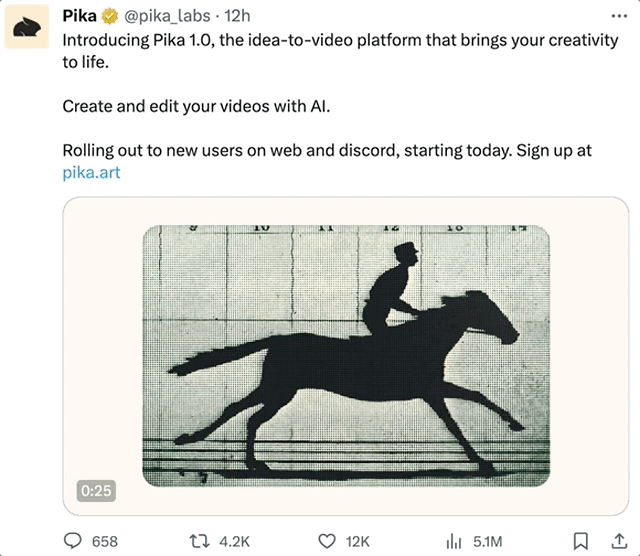
OpenAI’s Andrej Karpathy Retweets with Passion:
“Everyone can become a director of multimodal dreams, just like the dream architects in ‘Inception’.”
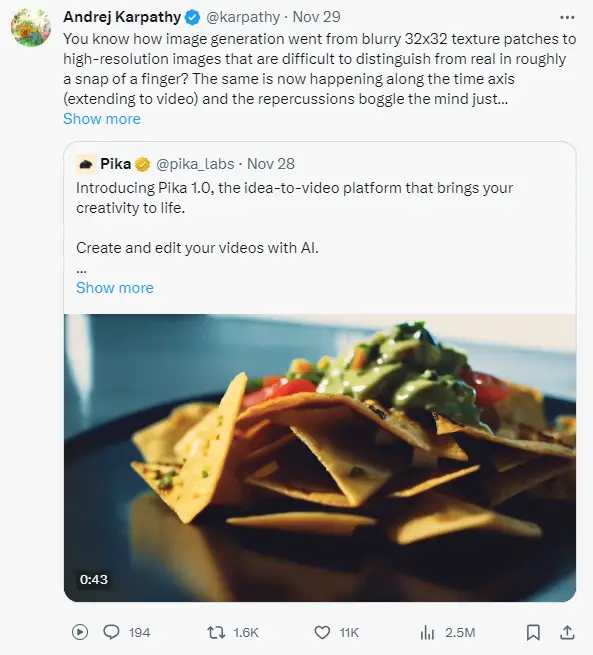
The new product, named Pika 1.0, is backed by the company Pika, established in April this year.

The new product, named Pika 1.0, is backed by the company Pika, established in April this year.
How Did This New Product Quickly Break Through and Attract Attention?
From the released demo, Pika 1.0 can smoothly generate a video from text and images, with instant dynamic transitions:

Moreover, Its Editability is Particularly Strong:
Specify any element in the video, and a single sentence can achieve a rapid “costume change”:

Such Effects Have Led to Over 520,000 Users in Just Six Months:
The company has also recently secured $55 million in funding, with individual investors including big names like Adam D’Angelo, founder of Quora, Aravind Srinivas, CEO of Perplexity, and Nat Friedman, former CEO of GitHub.

Advanced Features and How to Use Pika 1.0?
Transformative Video Editing
Pika 1.0 isn’t just about cutting and joining clips. It’s about reimagining your footage. With features like style transformation and content alteration, your videos will never be the same. Imagine turning a simple video into a 3D animation or an anime adventure!
Not Only Can It Generate Videos from Text, Images, or Video Styles:
But it can also edit parts of the video.

How Strong is the Editability?
Not only can the frame size be freely expanded, from 5:2, 1:1 canvas, to 9:16 and 16:9 widescreen, but there are also four seamless transition options:

Styles Like 3D, Anime, Movies, and Various Filters Are Also Available:
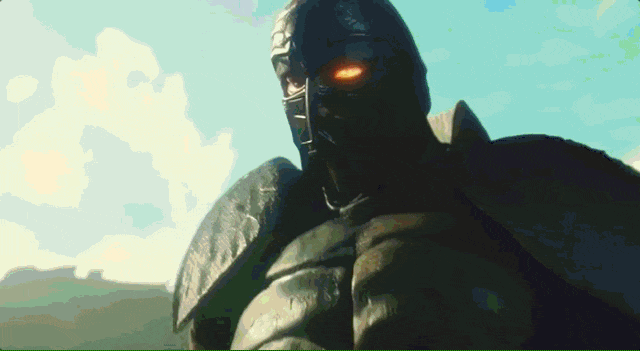
Intuitive User Interface
Ease of use is the name of the game. Pika 1.0’s user interface is so intuitive, even your grandma could become a video editing pro. Say goodbye to hours of figuring out complex software.
Alternatively, you can first experience it in the Discord community.
Although It Has Not Yet Updated to Pika 1.0 with the Web Version:
We also tested the text and image video generation effects, which were quite good.
After Joining the Community, Head Straight to “Creations”:
Choose any of the 10 generation areas below to start playing.
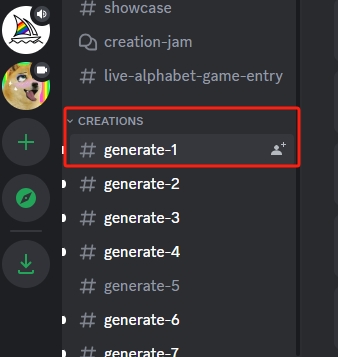
In the Input Box, Type “/”:
Select the simplest “/create” command:
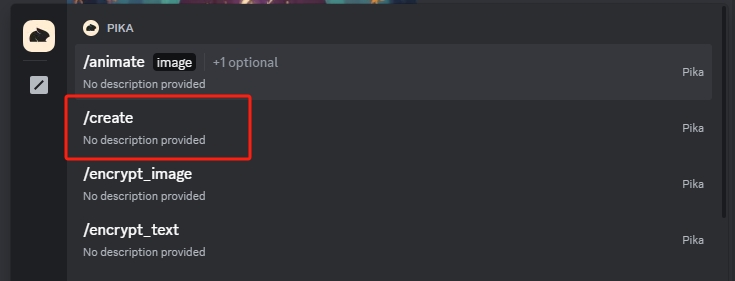
AI-Powered Creativity
Unleash your creativity with AI at your fingertips. Pika 1.0 understands your vision and helps bring it to life, whether it’s extending video lengths or adding fantastical elements to your footage.
We Tried Slightly Longer Prompt:
“a vast burning wasteland of lost souls in Hell”
Still Super Fast, and the Result Was Out:

Besides Pure Text, We Can Also Upload an Image for Reference and Use the “/animate” Command:
Voila, a static meme comes to life:

Overall, Pika’s Video Length is 3 Seconds:
(Using too long a prompt is useless, as it will be ignored), and it can’t guarantee satisfaction every time, but generally, trying a few times yields good results.
Beyond Our Own Testing, Let’s Look at Works from Netizens:
Some are quite stunning.
For Example, Someone Created This Little Monster:

And This Segment of Two Little Girls Playing Music:

After watching, it felt like I could really hear beautiful voices emanating from it.
The Most Amazing is This Scene of a Dove Circling a Short-Haired Beauty:
So atmospheric!

Founded by two Chinese PhDs from Stanford

In the rapidly evolving landscape of AI technology, the emergence of Pika, an innovative AI video generation company, stands out. Founded by two Chinese doctoral students from Stanford University, Demi Guo and Chenlin Meng, Pika represents a fusion of cutting-edge research and entrepreneurial spirit. Their journey from academia to the forefront of AI innovation is a testament to their expertise, dedication, and vision.
Demi Guo: A Blend of NLP and Graphics Expertise
Demi Guo, co-founder and CEO of Pika, has an impressive academic and professional background. Born in the United States and raised in Hangzhou, China, she displayed a penchant for technology from a young age. Her early achievements include winning a silver medal in the International Olympiad in Informatics (IOI) and attending the prestigious Hangzhou Foreign Language School. Her academic journey took her to Harvard University, where she pursued an undergraduate degree in mathematics and a master’s in computer science.
Guo’s interest in AI and NLP (Natural Language Processing) deepened during her time at Harvard. She took a gap year to work as a research engineer at Facebook AI Research, where she contributed significantly to a project analyzing 250 million protein sequences using Transformer technology. This work, cited over 1200 times, including by the renowned AlphaFold2, underscores her profound impact in the field.
Before co-founding Pika, Guo was a doctoral student at Stanford University’s AI Lab, focusing on NLP and graphics. Her decision to take a leave from Stanford for entrepreneurship reflects her commitment to applying her academic expertise to real-world challenges.
Chenlin Meng: From Computer Vision to AI Innovation
Chenlin Meng, co-founder and CTO of Pika, complements Guo’s expertise with her deep knowledge in computer vision and 3D vision. A Stanford graduate in mathematics, Meng’s academic journey is marked by significant contributions to generative AI research. She co-authored the Denoising Diffusion Implicit Models (DDIM) paper, which has been cited over 1700 times, highlighting her influence in the field.
Meng’s research interests extend to various aspects of AI, including generative models and their applications. Her work has been recognized at top conferences like ICLR, NeurIPS, CVPR, and ICML, often selected for oral presentations – a testament to the relevance and quality of her research.
The Genesis of Pika
The inception of Pika is rooted in Guo and Meng’s shared vision of harnessing AI for creative video generation. Their combined expertise in NLP, computer vision, and generative AI models provided a solid foundation for developing Pika’s flagship product, Pika 1.0. This tool represents a significant leap in AI video generation, allowing users to create videos from text and images with unprecedented ease and flexibility.
The development process involved extensive research and experimentation, leveraging their academic insights to address practical challenges in video generation. They focused on creating a user-friendly interface while ensuring the tool’s powerful capabilities in generating high-quality, customizable videos. Their approach was to make AI technology accessible and usable for a broad audience, from professionals in the creative industry to casual users interested in exploring the possibilities of AI-generated content.
Alternatives of Pika 1.0
Pika 1.0 has made a significant impact in the AI video generation market, but it’s not the only player in this field. Several other products offer unique features and capabilities. Understanding these alternatives can help users choose the best tool for their needs. Let’s explore some of these alternatives, their features, and how they differ from Pika 1.0.
1. Runway’s Gen-2
Runway’s Gen-2 is an AI tool designed for creative professionals, offering a wide range of machine learning models for video, image, and text generation.An update to the Gen-2 platform, introducing a “paint anywhere, move anywhere” motion pen feature.
- This function allows for greater control over the generative process, enabling users to dictate motion and animation with precision.It supports ultra-realistic 4K clarity works and provides a user-friendly interface for both beginners and professionals. It’s known for its versatility in handling various media formats.
- Difference from Pika 1.0: While Pika 1.0 focuses primarily on video generation from text and images, Runway’s Gen-2 offers a broader range of functionalities, including image and text manipulation.
- Recommendation: Ideal for users seeking a comprehensive tool for diverse creative projects beyond just video generation.
2. Meta’s Emu Video
Emu Video is a product from Meta (formerly Facebook) that emphasizes high-quality video generation.
- Key Features: It claims to surpass Gen-2 and Pika in user evaluations, particularly in terms of realism and quality.
- Difference from Pika 1.0: Emu Video focuses more on the quality and realism of the videos, potentially making it a better choice for projects where high fidelity is crucial.
- Recommendation: Recommended for users who prioritize video realism and are engaged in professional-level production.
3. ByteDance’s PixelDance
PixelDance is an AI video tool developed by ByteDance, known for its dynamic and non-deforming movements in video elements.
- Key Features: It stands out for its ability to handle large, complex movements without distortion, offering a high level of dynamism in videos.
- Difference from Pika 1.0: PixelDance excels in creating videos with significant movement and action, whereas Pika 1.0 is more versatile in generating videos from text and images.
- Recommendation: Best suited for users needing to create dynamic, action-packed videos.
4. Stable AI’s Stable Video Diffusion
A tool from Stable AI, focusing on the diffusion process in video generation.
- Key Features: Known for its impressive effects, Stable Video Diffusion uses advanced AI algorithms to create highly realistic and detailed videos.
- Difference from Pika 1.0: This product emphasizes the diffusion process, making it a strong contender for creating videos with intricate details and textures.
- Recommendation: Ideal for users who require detailed and texture-rich video content.
User Recommendation
When choosing an AI video generation tool, consider your specific needs:
- For Broad Functionality: Runway’s Gen-2 is versatile, suitable for a range of creative tasks.
- For High-Quality Realism: Meta’s Emu Video is ideal for professional-grade, realistic video production.
- For Dynamic Videos: ByteDance’s PixelDance excels in creating action-oriented, dynamic content.
- For Detailed Textures: Stable AI’s Video Diffusion is perfect for videos requiring intricate details.
- For Precise Control: Gen-2’s motion pen update is best for users needing granular control over video elements.
Each of these tools offers unique strengths, making them suitable for different types of projects and user requirements. Your choice should align with your project’s specific needs and your personal or professional goals in video production.
Final Thoughts
Pika 1.0 is not just a tool; it’s a doorway to a world where video creation is limited only by your imagination. Whether you’re a novice or a pro, Pika 1.0 is poised to be your go-to for bringing stories to life. So, are you ready to direct your masterpiece?

